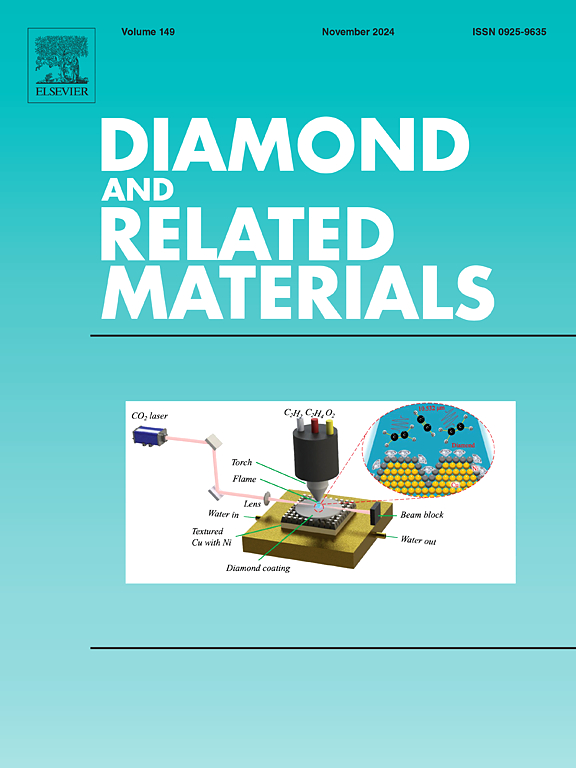500℃下棕榈仁壳单步制备n掺杂石墨烯粉末
IF 4.3
3区 材料科学
Q2 MATERIALS SCIENCE, COATINGS & FILMS
引用次数: 0
摘要
棕榈油工业的快速增长导致了大量废物的产生,包括棕榈仁壳(PKS),一种未充分利用的农业生物质。本研究探索了在中等温度下通过单步加热工艺将PKS可持续地转化为石墨和氮掺杂石墨烯。在450°C和500°C下优化碳化,并改变停留时间(30、60和90 min),以促进石墨碳的形成。利用拉曼光谱、热重分析(TGA)、CHNS、x射线衍射(XRD)、高分辨率透射电子显微镜(HRTEM)、扫描电子显微镜(SEM)、能量色散x射线(EDX)测绘和x射线光电子能谱(XPS)进行了综合表征,以评估其结构、热和成分特征。Raman反卷积和Tuinstra-Koenig (TK)关系式计算表明,样品的结晶度百分比在33.72% ~ 37.00%之间,在450℃、90 min的碳化条件下,石墨有序度最高。TGA结果表明,样品在500℃、60 min的碳化条件下具有最高的热稳定性,而XRD证实了无定形碳和结晶矿物相(如碳酸钙和磁铁矿)的存在,解释了元素CHNS数据中17.3%的差异。对500℃、90分钟的碳化样品进行球磨,得到的石墨烯层数较少,ID/IG比为0.65,I2D/IG为0.33。XPS分析证实了氮原子的掺入,表明来自生物质的被动自掺杂。该研究展示了一种成本效益高、可扩展且环保的途径,可以从PKS中生产氮掺杂石墨烯,解决农业废弃物增值问题,同时在储能、催化和环境修复方面具有前景。本文章由计算机程序翻译,如有差异,请以英文原文为准。

Single-step production of N-doped graphene powder from palm kernel shell at 500 °C
The rapid growth of the palm oil industry has led to significant waste generation, including palm kernel shells (PKS), an underutilized agricultural biomass. This study explores the sustainable conversion of PKS into graphitic and nitrogen-doped graphene through a single-step heating process at moderate temperatures. Carbonization was optimized at 450 °C and 500 °C with varying dwelling times (30, 60, and 90 min) to enhance graphitic carbon formation. Comprehensive characterization using Raman spectroscopy, thermogravimetric analysis (TGA), CHNS, X-ray diffraction (XRD), high-resolution transmission electron microscopy (HRTEM), scanning electron microscopy (SEM), energy-dispersive X-ray (EDX) mapping, and X-ray photoelectron spectroscopy (XPS) was conducted to evaluate structural, thermal, and compositional features. Raman deconvolution and Tuinstra-Koenig (TK) relation calculations revealed crystallinity percentages ranging from 33.72 % to 37.00 %, with the highest graphitic order observed in the sample carbonized at 450 °C for 90 min. TGA showed that the 500 °C, 60-minute condition achieved the highest thermal stability, while XRD confirmed the presence of both amorphous carbon and crystalline mineral phases such as calcium carbonate and magnetite, explaining the 17.3 % discrepancy in elemental CHNS data. Ball milling of the 500 °C, 90-minute carbonized sample produced few-layer graphene with an ID/IG ratio of 0.65 and I2D/IG of 0.33. XPS analysis verified the incorporation of nitrogen atoms, indicating passive self-doping derived from the biomass. This study demonstrates a cost-effective, scalable, and eco-friendly route to producing nitrogen-doped graphene from PKS, addressing agricultural waste valorization while enabling promising applications in energy storage, catalysis, and environmental remediation.
求助全文
通过发布文献求助,成功后即可免费获取论文全文。
去求助
来源期刊

Diamond and Related Materials
工程技术-材料科学:综合
CiteScore
6.00
自引率
14.60%
发文量
702
审稿时长
2.1 months
期刊介绍:
DRM is a leading international journal that publishes new fundamental and applied research on all forms of diamond, the integration of diamond with other advanced materials and development of technologies exploiting diamond. The synthesis, characterization and processing of single crystal diamond, polycrystalline films, nanodiamond powders and heterostructures with other advanced materials are encouraged topics for technical and review articles. In addition to diamond, the journal publishes manuscripts on the synthesis, characterization and application of other related materials including diamond-like carbons, carbon nanotubes, graphene, and boron and carbon nitrides. Articles are sought on the chemical functionalization of diamond and related materials as well as their use in electrochemistry, energy storage and conversion, chemical and biological sensing, imaging, thermal management, photonic and quantum applications, electron emission and electronic devices.
The International Conference on Diamond and Carbon Materials has evolved into the largest and most well attended forum in the field of diamond, providing a forum to showcase the latest results in the science and technology of diamond and other carbon materials such as carbon nanotubes, graphene, and diamond-like carbon. Run annually in association with Diamond and Related Materials the conference provides junior and established researchers the opportunity to exchange the latest results ranging from fundamental physical and chemical concepts to applied research focusing on the next generation carbon-based devices.
 求助内容:
求助内容: 应助结果提醒方式:
应助结果提醒方式:


